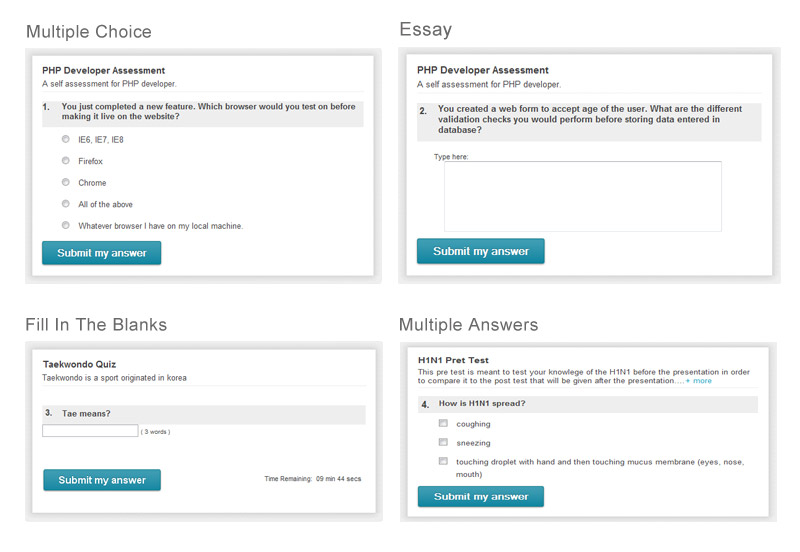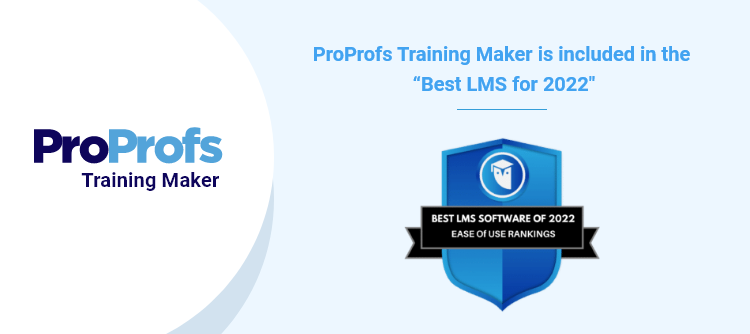 ProProfs Quiz Maker is a popular online assessment software. One reason for its popularity is the ability to choose from various types of questions when creating an assessment.
ProProfs Quiz Maker is a popular online assessment software. One reason for its popularity is the ability to choose from various types of questions when creating an assessment.
The following types of questions are available using ProProfs Quiz Maker. Learn the best method for creating each one using simple techniques and administration preferences.

1. Multiple-Choice Questions
Multiple choice questions state a question followed by a list of possible answers, with only one of those answers being correct.
How to:
When writing multiple-choice questions, present your problem using simple but precise language. Make each question as concise and clear as possible. Good multiple choice questions present alternative answers that also relate to the question in some way. Do not use alternate answers that are meant to trick or purposely confuse students.
With multiple-choice questions you can assess how well students have memorized important information or how well they use deductive reasoning to find a solution to a posed problem.
Advantages:
- Easy to score using automatic scoring, with only one correct answer possible
- Can be used to measure various learning outcomes, both simple and complex
- Measures specific ideas or concepts clearly
Disadvantages:
- Too easy for the instructor to only focus on assessing simple recall or facts
- Can be difficult to construct complex, interesting questions
- Not useful to measure skill ability or performance
- Subject to random guessing if answers are not carefully constructed
2. True/False Questions
True/False questions present a statement that must be identified as either true or false.
How to:
When writing true/false questions, keep statements brief. Avoid vague or confusing language. Do not attempt to trick students by using trivial statements. Write questions that are either entirely true or entirely false. Each question should focus on only one idea. Avoid general statements or statements that include the words “always” or “never.” Avoid the use of negative wording. If using ideas or concepts from a course text, do not use the exact wording, but rephrase the statement.
Include more false statements in a test than true ones. Vary the number of false statements from test to test. Use True/False questions sparingly.
Advantages:
- Easy to write
- Simple to score using automatic scoring
- There is always only one correct answer
- Tests one clear idea or concept
Disadvantages:
- Measures only low-level learning such as knowledge, comprehension, or facts
- Guessing has a higher possible success ratio, with a 50/50 chance to be correct
- Guessing is more likely
- Sometimes viewed by students as a boring, poor or unfair method of scoring
- Relies on rote memorization
Watch How to Create an Assessment Online
3. Check-All Questions
The Check-all question (multiple select) is a variation of the multiple-choice question in online assessments. In the Check-all question there is typically more than one correct answer.
How to:
The Check-all question requires accurate instructions. Selections need to be related in some way to the core question. Use answer options that are plausible, and order them logically. The Check-all question works best with less than ten possible answers to choose from. When using multiple Check-all questions in a test, vary the number of possible answers.
With Check-all questions you can test knowledge for terms and definitions, cause and effect, parts and their functions, and procedures and operations. The idea behind the check-all question is making associations with a main idea.
Advantages:
- Quite easy to write
- Simple to score using automatic scoring
- Work well with the use of visual aids such as maps or diagrams, pictures, and graphs
Disadvantages
- Difficult to use for assessing interpretation or application of knowledge
- Encourages rote memorization
- Higher margin of error in choosing multiple selections due to students not reading carefully
4. Short Answer Questions
Short answer questions are also known as fill-in-the-blank. These questions are used to check recall for details that identify specific ideas, names, or parts.
When writing short answer questions try to phrase questions so there is only one possible answer. For best results, use direct questions, not an incomplete statement. If you do choose to use incomplete statements, use only one blank within each item. Good Short-answer questions require specific, exact information. When creating your list of possible answers include any acceptable option including synonyms, capitalization variations, possible misspellings (if acceptable), and any other acceptable alternate answer. Be prepared to review student answers that don’t match your allowable options, but are still acceptable. Take the time to read student responses, and don’t rely entirely on your quiz maker to grade these answers.
Short-answer questions work well with an attached visual aid. They are successful when used to distinguish identifiable items in a diagram, for example.
Using short answer questions can help assess student knowledge, comprehension, plus some application and evaluation skills. This type of question is not useful in assessing how students interpret information.
Advantages:
- Questions are generally easy to construct
- Minimizes guessing
- Encourages deeper study
- Can assess more types and levels of learning
- Gives a more accurate analysis of student knowledge, since students must construct their answer
Disadvantages:
- Must allow for a correct answer not included in answer options
- Take longer to score than other question types
- May put too much emphasis on memorization
- Grading can be subjective
5. Essay Questions
With essay questions you are better able to evaluate how well a student grasps information through their expression and organization of words. Additionally, essay questions allow students to pose a solution to a given problem. However they are the most subjective type of questions because they allow students to write responses using their own words.
When writing essay questions, focus on one specific idea, asking a question that can be answered within a few minutes. Use brief, concise language. Indicate whether you want a response that includes only facts, or also student opinion.
Advantages:
- Can assess reasoning, application, and critical thinking
- Relatively easy to construct
- Reduces guessing
- Gives students a chance to express opinions or creative ideas
Disadvantages:
- Takes extra time in grading
- Is subjective to teacher opinion
- There may be no right or wrong answer
- Teacher focus can be swayed by misspellings, grammar or other content errors when these are not part of that particular course’s objectives
Watch: How to Choose Best Assessment Software
In Summary
Knowing a few techniques for creating each type of question can help in making your questions a highly effective means of evaluating student learning. The more practice you get, the better your questions will be.
Creating quality assessments takes practice. Using these guidelines, you’ll be able to create an effective, quality assessment, ready to distribute to your next group of students.
For creative and engaging ideas to use in your assessments, see Five Effective Tips to Encourage Student Engagement and 6 Engaging Ways To Use ProProfs Quiz Maker In The Classroom.
So why wait? Get started using ProProfs Quiz Maker today!





